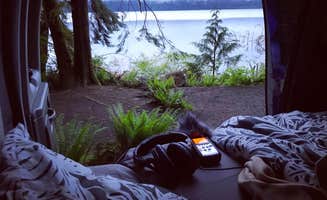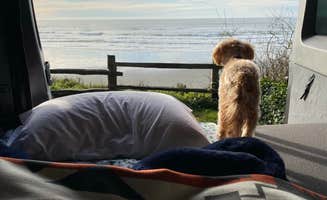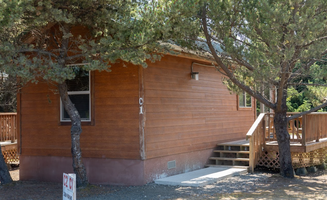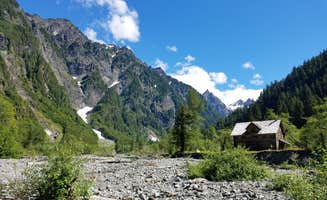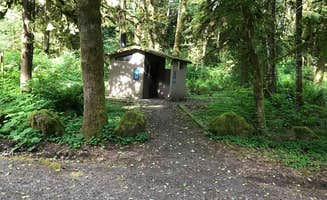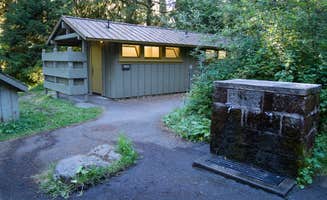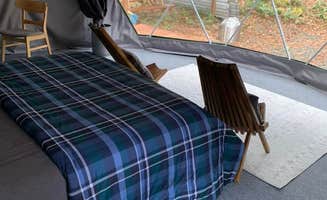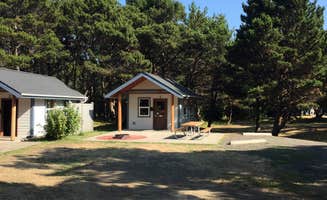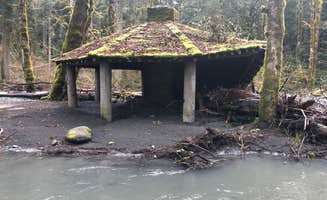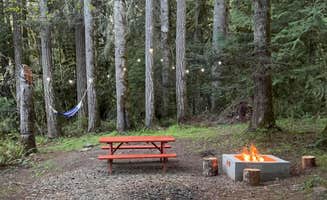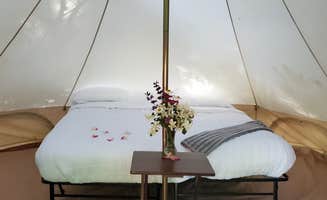Lake Quinault sits within a temperate rainforest that receives over 140 inches of annual rainfall, creating a lush environment with moss-covered trees and abundant ferns. The lake covers 3,729 acres with depths up to 250 feet, surrounded by Olympic National Forest lands. Winter camping often brings temperatures between 35-45°F with near-constant drizzle, while summer offers more moderate conditions with daytime highs rarely exceeding 75°F.
What to do
Hike to waterfalls: Falls Creek Campground offers direct access to several small waterfalls within walking distance. "Beautiful river and forest. Sites right on the riverside. Water was high enough to do some laps on a whitewater kayak. Short, accessible path to waterfall," reports emily F. from Falls Creek Campground.
Watch winter storms: Kalaloch Campground provides prime locations for storm watching during winter months. "I prefer winter camping here because its less crowded, and the storms coming in from the Pacific are nothing less than awe inspiring," writes Toby R., who visited during the off-season.
Visit the World's Largest Spruce: Take a short walk from Rain Forest Resort Village to see this impressive natural landmark. "Very pretty resort on the lake and next to the worlds largest spruce tree. Plenty of trails to walk from here too," notes Vik H.
Kayak the lake: Bring your own watercraft or rent one locally to explore Lake Quinault's shores. "The lake is just fabulous and offers great swimming and paddling," reports JeffT from Falls Creek Campground, who recommends visiting even when most sites are reserved.
What campers like
Waterfront access: Many campers appreciate sites with direct water views. "About half the campsites are on the lake and if you can you want one of those ones!! We had site 10 and the view was amazing," shares Kim B. from Willaby Campground.
Private-feeling sites: Despite close proximity, vegetation creates natural barriers. "Our campsite was very wooded and visually pretty private, despite road traffic very nearby," mentions Rebecca M. about Willaby Campground, where the forest creates natural separation between sites.
Winter solitude: Off-season camping offers quieter experiences with fewer crowds. At Kalaloch Campground, "The winter months are the best months to go," according to Toby R., who enjoys watching Pacific storms roll in when crowds have thinned.
Yurt accommodations: For those seeking yurt camping near Amanda Park, Washington, several options exist. "Lots to do in this campground and tons of fun 4th of July weekend! Paved campground with pull through sites," reports Bradee A. about Coho Campground, which offers yurts as an alternative to traditional tent sites.
What you should know
Make reservations early: Popular lakefront sites fill quickly, especially in summer. "We were lucky enough to get 1 site that wasn't reserved for a night," explains JeffT about Falls Creek Campground, adding that they found this site despite visiting "on a super busy weekend at the end of August."
Limited services: Most campgrounds have basic amenities but lack showers or hookups. "No sewer, so plan for that," advises Patrick J. about Rain Forest Resort Village, while Michael K. notes about Kalaloch, "Seriously why do we not have showers at incredibly popular National Parks."
Pack for rain: Even in summer, prepare for wet conditions. At Sol Duc Hot Springs Resort, Brendan A. advises, "Just a note: it is WA so plan on getting wet and muddy. Everything was constantly wet around Sol Duc. Plan and pack accordingly!"
Tent size restrictions: Some campgrounds limit tent dimensions. "Each of the sites has... a tent pad limited to 10' x 10'. Sadly, our tent was too large so we had to park sideways and place our tent in the parking spot," reports Bethany P. from Falls Creek Campground.
Tips for camping with families
Beach access: Pacific Beach State Park offers family-friendly shoreline activities. "Dogs love to run up and down the beaches!" notes Jessica C. from Pacific Beach State Park, which is directly adjacent to the ocean.
Child-friendly exploration: Look for campgrounds with open spaces for children to play. "Nice for kids on bikes, swimming, big grassy fields, lots of trails!" recommends ashley E. about Wynoochee Falls Campground, highlighting its versatility for younger campers.
Campfire options: Not all campgrounds allow fires at individual sites. "No campfires except on the beach," advises Laurie W. about Pacific Beach State Park, providing families with an alternative location for evening fires.
Day use areas: Willaby Campground offers accessible beach facilities even if you aren't staying overnight. "There's also a boat launch and a pretty great beach down towards the water that gets you right out onto the lake," explains Zach A., noting the $25 nightly fee includes access to these amenities.
Tips from RVers
Limited hookup availability: Most campgrounds near Amanda Park offer few or no hookups. "We had to buy 30 amp converter so we could plug in our 120 to charge our batteries," shares adelia from Rain Forest Resort Village, highlighting the need to bring adapters.
Tight maneuvering: Several campgrounds have narrow roads that challenge larger rigs. At Willaby Campground, Rebecca M. notes it's "very close to the main road," while others warn about backing difficulty due to "random boulders here and there which may impede your maneuvering."
Campsite size variability: Many campgrounds have inconsistent site dimensions. "Sites vary in size. Some are tiny and cramped up to your neighbor and some are large and private," notes marcus K. from Sol Duc Hot Springs Resort, recommending checking specific site details before booking.
Dump station locations: Plan ahead for waste disposal. "The closest dump site was an hour away. No internet or cell service," reports Amy from Rain Forest Resort Village, emphasizing the need to manage tank capacity during longer stays.


